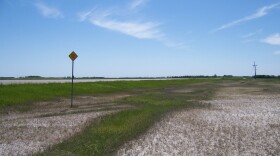Not so many years ago the sighting of a bald eagle was an uncommon to rare occurrence in North Dakota. Now, of course, these magnificent birds are much more frequently observed, even during the winter months. You may have missed it, but eagles have been the news recently, and all is not well with them.
The February 17 issue of Science, the weekly scientific journal of the American Association for the Advancement of Science, published the results of an eight-year study that evaluated lead exposure of over 1,200 bald and golden eagles from 38 states. Forty-six percent of the bald eagles and 47% of golden eagles showed signs of chronic lead poisoning. Twenty-eight percent of the bald eagles has acute lead poisoning.
The toxic effects of lead in animals have been known for years and is the main reason it was removed from gasoline and paint, for example. In the eagles it affects motor skills and impairs the bird’s ability to fly and digest food, and can be fatal, directly as well as indirectly.
According to the University of Minnesota’s Raptor Center, “The Raptor Center’s clinic admits over 150 injured and ill bald eagles each year with 85-90% showing some level of lead in their blood. On average, 25-30% of these eagles are documented to have lead toxicity.” They go on to state that research has shown that lead toxicity in eagles and other avian scavengers is strongly correlated with deer hunting season.
It is well known that bald eagles often feed on the carcasses unclaimed deer (the ones what were shot but got away). They also feed on the gut piles of field dressed deer. In the process they may repeatedly ingest small fragments of lead. Consuming the equivalent of two #6 pellets from a shotgun shell is enough to kill a bald eagle.
And it is not just the eagles that are being poisoned. Lead is undoubtedly affecting other animals as well. Non-toxic shot is already in use for waterfowl hunting and is required for all waterfowl hunting in the state. That is also true for waterfowl hunting on all U.S. Fish and Wildlife refuges and waterfowl production areas. And it is interesting to note that no lead sinkers and jigs are now required in Canada’s National Parks and National Wildlife Areas. Non-toxic ammunition is available for rifles, perhaps it is time to make that switch to non-toxic rifle bullets as well.
- Demographic implications of lead poisoning for eagles across North America. Science February 12, 2022: Read >
- Science article about the study: Read >
- Groundbreaking Study Finds Widespread Lead Poisoning in Bald and Golden Eagles (USGS): Read >
- University of Minnesota’s Raptor Center’s page on the lead poisoning in bald eagles: Read >
- Fact Sheet: Bald Eagles and Lead Poisoning (Iowa Department of Natural Resources): Read >




